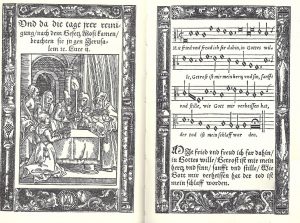The Song of Simeon — commonly referred to as the Nunc dimittis, the first two Latin words in the canticle — has been part of Christian worship since Jesus was a baby. Before the Reformation in the West, it would typically have been chanted in Latin by clergy. In the 1520s, Martin Luther — eager to share the privilege of affirming the sentiments of Simeon’s song with all believers — wrote a 4-stanza hymn that paraphrased and amplified Simeons’s affirmations:
1. Mit Fried und Freud ich fahr dahin / in Gotts Wille;
In peace and joy I now depart / At God’s disposing;
getrost ist mir mein Herz und Sinn, / sanft und stille,
For full of comfort is my heart; / Soft reposing.
wie Gott mir verheißen hat: / der Tod ist mein Schlaf worden.
So the Lord hath promised me, / And death is but a slumber.
2. Das macht Christus, wahr’ Gottes Sohn, / der treu Heiland,
’Tis Christ that wrought this work for me, / My faithful Savior,
den du mich, Herr, hast sehen lan / und g’macht bekannt,
Whom Thou hast made mine eyes to see / By Thy favor.
dass er sei das Leben mein / und Heil in Not und Sterben.
Now I know He is my Life, / My help in need and dying.
3. Den hast du allen vorgestellt / mit groß Gnaden,
Him Thou hast unto all set forth / Their great Salvation;
zu seinem Reich die ganze Welt / heißen laden
And to His kingdom called the earth, / Ev’ry nation.
durch dein teuer heilsam Wort, / an allem Ort erschollen.
By Thy dear and wholesome Word, / In ev’ry place resounding.
4. Er ist das Heil und selig Licht / für die Heiden,
He is the Hope and saving Light / Of lands benighted;
zu ‘rleuchten, die dich kennen nicht, / und zu weiden.
By Him are they who dwelt in night / Fed and lighted.
Er ist deins Volks Israel / Preis, Ehre, Freud und Wonne.
He is Israel’s Praise and Bliss, / Their Joy, Reward, and Glory.

Luther wrote a delicate melody to go with this text, and for centuries tune and text were common in Lutheran Vespers. Whereas the tune he wrote for his paraphrase of Psalm 130 (Aus tiefer not) begins with a dramatic descending interval, the tune to Mit Fried und Freud begins with a dramatic ascent — an entire octave within the first five notes. Simeon’s anticipation of his death is an anticipation of his own ascent.
Here is a solo voice singing the first verse of Luther’s Mit Fried und Freud.
You may download a pdf of an English translation of Luther’s hymn (with four-part harmony) here.
Many composers have adapted this melody for choir and for organ. In 1674, Dieterich Buxtehude (c.1637-1707) wrote a work in honor of his recently deceased father called Fried- und Freudenreiche Hinfarth (“Departure enriched by Peace and Joy”). He intended it as a composition to be sung at funerals. Here is a performance of Buxtehude’s work performed by members of the Amsterdam Baroque Orchestra and Choir, conducted by Ton Koopman.
In addition to composing a chorale prelude for organ on Luther’s melody, Johann Sebastian Bach (1685-1750) wrote a cantata for the Feast of Purification of the Blessed Virgin Mary (Mit Fried und Freud ich fahr dahin, BWV 125). Three of the cantata’s six movements feature Luther’s hymn text and tune. Especially notable is the opening chorus which is strikingly reminiscent of the opening of Bach’s St. Matthew Passion. The text is the first verse of Luther’s hymn, which is (as Julian Mincham writes) “rich with imagery and undertones; death, sleep, a journey of departure, peace and consolation are some of the intertwined themes and images. Bach is always at his most creative and imaginative when dealing with such complexities.”
Here is Bach’s Mit Fried und Freud ich fahr dahin, sung by Collegium Vocale Gent, conducted by Philippe Herreweghe. The alto soloist is Ingeborg Danz, the tenor is Mark Padmore, and Peter Kooy is the bass.
The final movement to Johannes Brahms’s 1877 motet Warum ist das Licht gegeben? (more on this work soon!) is a four-part chorale displaying Brahms at his most Bachian. It is sung here (along with a scrolling video of the musical score) by the Utrechtse Studenten Cantorij.